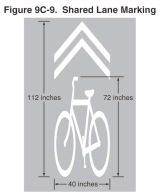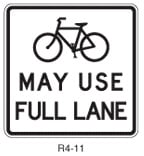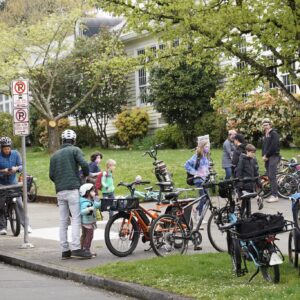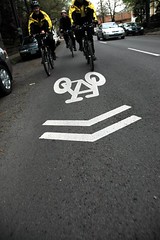
this one in San Francisco, are
now officially recognized by
the FHWA.
(Photo © J. Maus)
This morning the Federal Highway Administration released a 135-page comprehensive update to their Manual on Uniform Traffic Control Devices (MUTCD), a standards guide that has driven (pun intended) the design of traffic controls in America for over three decades.
In a press statement, U.S. Transportation Secretary Ray LaHood said the updates — the first major changes since 2003 — where part of a “continuing effort to improve safety on the nation’s roads and bridges”. Several of the new updates will make it easier for city traffic engineers across the country to implement signs, signals, and markings that improve conditions for biking and walking.
Some of the key changes to the MUTCD that benefit bike and foot traffic are:
- the addition of shared-lane markings (also known as “sharrows”),
- the addition of “Bicycles May Use Full Lane” signage,
- an improved U.S. Bike Route sign,
- the addition of bike route guide signs ,
- new guidance for deciding when a new traffic signal can be installed,
- and changing the formula used to calculate crosswalk times to give walkers more time.
Sec. LaHood specifically referenced these changes in today’s press statement:
“By requiring better pavement markings which can increase bike lane safety, and extending walk times for pedestrians at crosswalks, the updated MUTCD furthers the “complete streets” concept – an effort long championed by the FHWA [some folks might chuckle a bit at that — Ed.] to ensure roads accommodate all types of travel, not just automobiles.”

from the MUTCD.
For more on shared-lane markings, here’s a snip from the official Federal Register:
This pavement marking indicates the appropriate bicyclist line of travel, and cues motorists to pass with sufficient clearance, and is based on field research conducted in San Francisco, CA. The purpose of this marking is to reduce the number and severity of bicycle- vehicular crashes, particularly crashes involving bicycles colliding with suddenly opened doors of parked vehicles.
Portland City Traffic Engineer Rob Burchfield seemed pleased with the news about shared-lane markings when I spoke to him about it this morning. “This absolutely makes it easier and more straightforward for us to put them in.” Burchfield said PBOT plans to install 2,000 shared lane markings in their bike boulevard projects in the coming years (thanks to a federal stimulus grant that’s funding the markings and signage of the bike boulevards).

numbered bike routes.
Adventure Cycling’s U.S. Bicycle Route System effort got strengthened a bit by this MUTCD update. The FHWA decided to revise the U.S. Bike Route Sign by putting a larger bicycle symbol on the top part of the sign with a smaller number below it. The reason for the change, “is to present an immediate impression of a ‘bicycle numbered route’ rather than a ‘highway numbered route which can also be used by bicyclists'”.
Another sign that the FHWA is slowly moving away from their auto-centric roots is a change to a section titled Adequate Roadway Capacity. The new MUTCD includes a paragraph offering guidance to engineers against taking a widen-it-first approach to adding capacity. From the Federal Register:
“… add a paragraph… that additional methods for increasing roadway capacity that do not involve widening a signalized intersection should be carefully evaluated. Such methods could include revising pavement markings or lane-use assignments where appropriate.”
The FHWA cited the need to recommend “lower cost options” and they also agreed with comments that “any impacts to bicyclists should also be considered” in all projects that aim to increase roadway capacity.

Bike route guide signs.
|

This will please a lot of people.
|
One source I spoke to this morning said the most important change to the MUTCD has to do with criteria used to determine when a traffic signal can be installed. The new MUTCD makes it easier for engineers to install traffic signals where bikeways and trails cross larger arterial streets based not just on volume of non-motorized traffic, but on how long of a delay they experience.
This is crucial, because engineering analysis of some crossings would yield low counts of biking and walking traffic simply because the crossing is so intimidating and dangerous. Now, with the new rules, this catch-22 is avoided and the decision is much more friendly to biking and walking traffic that it has been in the past.
This MUTCD update includes a lot of revisions and additions to how the FHWA handles non-motorized transportation and it shows their acknowledgment of — not just external pressures to innovate more quickly — but of a changing traffic mix in America.
You can peruse the chapter in the MUTCD devoted to “Traffic Controls for Bicycle Facilities” on the FHWA website.





Sounds like good news all around. Thanks for the info.
That seems encouraging, and I think the biggest thing to me is that it seems to be a little more open to allowing localities to find or implement solutions which fit their traffic problems (not just their car flow problems), which I think is extremely important. Portland is not Chicago is not Houston, and each of those places has different needs and desires to help make their own traffic as safe as possible, and they should be able to create solutions which fit their unique issues, as well as using standardized solutions where it’s appropriate.
On that note, can we get a traffic signal at 24th on E Burnside? 😀
They mention San Francisco as a contributor of new features, but I wonder if Portland gets any credit. I suppose I have to read the link.
For specifics on the changes to the bike and ped chapter take a look at this PowerPoint presentation…see chapter 9.
http://mutcd.fhwa.dot.gov/ser-Training.htm
Portland City Traffic Engineer Rob Burchfield seemed pleased with the news about shared-lane markings when I spoke to him about it this morning. “This absolutely makes it easier and more straightforward for us to put them in.” Burchfield said PBOT plans to install 2,000 shared lane markings in their bike boulevard projects in the coming years (thanks to a federal stimulus grant that’s funding the markings and signage of the bike boulevards).
This is all well and good, but the places where sharrows markings are really needed is on arterial streets like East 28th and SE Hawthorne where there is not enough room for bike lanes and the lanes are not wide enough for a motorist and a cyclist to share the lane.
Great news…Hey ODOT the St. John’s Bridge is waiting for those sharrow markings!!
“By requiring better pavement markings which can increase bike lane safety, and extending walk times for pedestrians at crosswalks, the updated MUTCD furthers the “complete streets” concept – an effort long championed by the FHWA [I know a lot of people who got a chuckle out of that] to ensure roads accommodate all types of travel, not just automobiles.”
Was the parenthetical statement in the above paragraph an editorial note or part of the press statement? I can’t imagine the latter- perhaps you should separate it typographically if it’s the former.
That minor quibble aside- One of the things that I really appreciate about Bike Portland is the ability to dig into policy stuff like this and deliver the actual on the ground possibilities to people like me who have an interest, but not enough wonk chops to track down stuff like this and figure it out.
Thanks and keep up the good work!
[Cycler. I realize that was not as clear as it could have been. It was my editorial addition of course. I’ve changed it a bit to better reflect that. Sorry for the confusion. — Jonathan ]
Lots of good wording and rules for road engineers favoring cycles, at least compared to the way it has been.
There seems to be a lot more on roundabouts than I remember from the last time I perused the MUTCD. I know that roundabouts terrify some cyclists, and there might be some studies showing if that fear is justified (where?), but overall they will slow down auto drivers and encourage more attentive driving.
This a Good Thing(tm).
Are those little arrows to show bikes which direction they are supposed be going in a lane? Do they also right STOP at the intersections for them also?
So the blog’s name is “Bike Portland,” but instead of sending sending someone downtown, it uses some stock photo from San Fransisco as a sharrow example. FAIL!
Similarly, I’d love to see far less of a self-interested group like Adventure Cycling in their involvement in the US Numbered Bike Route system. So far, their efforts have largely been ineffectual and have been unable to provide connections to places where they already have critical mass (or 76 would already be complete to Oregon). We need a more selfless group that’s more interested in utility cycling to help promote a system more comparable to the Interstate Highway System for cyclists, focusing on providing fast, relatively flat routes with high standards (pavement, proper markings, etc) instead of a glorified rails-to-trails program.
Paul,
The FHWA cited a study done in San Francisco in their sharrows recommendation. Also, I took that photo during a trip to SF a few years go… it is not a “stock photo”.
I’ve already got many photos of Portland’s sharrows, so I wouldn’t need to “send someone downtown” to get one.
Perhaps this will make you feel better:

Thanks for reading!
I would’ve liked to see Bike Boxes in there. Maybe next time. But still, Hurrah!
Hey Batman,
Did Adventure Cycling kill your parents?
Please open a forum thread and air your grievances there.
“the addition of ‘Bicycle Allowed Full Lane’ signage”
The new sign says Bikes MAY Use Full Lane, not “allowed”. Perhaps you have seen some yellow Bikes Allowed Use of Full Lane signs? The BAUFL sign never was in the MUTCD and was specifically excluded from the new MUTCD, making them non-compliant and their installation unlawful.
Very informative, thanks!
One thing that troubles or confuses me a bit is a piece of the excerpt from the Fed. Register above, about sharrows: “This pavement marking indicates the appropriate bicyclist line of travel,…”.
There are sharrows in block where SW Stark runs into Naito Pkwy, in the right lane. But what if you want to turn left onto Naito? I asked at a BTA Volunteer Saturday and the consensus was, get in the left lane, so as to make the left turn legally. The sharrows there — and the definition of what they are supposed to indicate quoted above — seem to add unnecessary confusion. It’s a signal to cyclists and drivers to expect bikes in the right lane, but really everyone should expect bikes in either lane, and everyone should feel comfortable riding in either lane, depending upon which way one wants to turn at the end of the block. Having the sharrows on the right makes me feel a little uncomfortable riding in the left, like I’m not supposed to be over there.
It’s not that I don’t think sharrows aren’t a useful and positive development. I just think more care needs to go into where and how they’re used.
It turns out that the minimum MUTCD sharrows placement standard really isn’t all that good; it requires placing the center of the sharrows marking a minimum of 11′ from the curb if curb side parallel parking is present.
By my calculations that puts the center of the sharrows only three feet from the parked cars and the right edge of a 40″ wide sharrow less than one foot from the parked cars, in other words, the entire right half of the sharrow markings will be squarely in the door zone.
This placement would also be in the right tire track of motor vehicles and make the sharrows subject to tire wear.
In my opinion, sharrows should be centered more fully in the lane. So the question then becomes, will the city of Portland use the minimum standard, or will they improve upon it?
I’m with Michael M. Sharrows send the wrong message–i.e. that there are specific, marked streets where cars should expect bikes to use the lane. Wrong message.
Sharrows distract from the core need to educate all drivers that bikes belong in traffic lanes (albeit “as far to the right as is practicable”…to me, “practicable” means four feet to the left of parked cars so that I don’t get doored, or four feet from the road edge so that I don’t get blowout from glass and gravel collecting at the roadsite and NOT swept up by the city.)
I’m with Michael M. Sharrows send the wrong message–i.e. that there are specific, marked streets where cars should expect bikes to use the lane. Wrong message.
Sharrows distract from the core need to educate all drivers that bikes belong in traffic lanes (albeit “as far to the right as is practicable”…to me, “practicable” means four feet to the left of parked cars so that I don’t get doored, or four feet from the road edge so that I don’t get blowout from glass and gravel collecting at the roadside and NOT swept up by the city.)
@ Michael M – in reality, your problem is not with the sharrows markings per se ;but rather, with the location PDOT choose to place them. That’s a problem with lots of bicycle-specific infrastructure, including bike lanes in the door zone and bike lanes and cycle tracks located to the right of right turning traffic.
@ craig – the explicit purpose of sharrows is to educate drivers that bikes belong in traffic lanes. In the absence of any other useful messages from PDOT, ODOT or the DMV, what other tools are there to do this with? Given the current lack of motorist education, how many motorists do you think actually understand why you are riding so far out in the lane from the parked cars, in the absence of cues like sharrows markings?
BURR, you’re beautifully restating my point. We need PDOT to run a publicity campaign on billboards, TV, and elsewhere. Sharrows serve to only “educate” drivers about that particular marked roadway, and imply that other unmarked roads don’t have the same use.
agree with burr 6 that sharrows are wasted on bike boulevards, but are needed on 28th, etc., where a cyclist needs to take the lane. craig 21/22 identifies an interesting perceptual problem, for which maybe a media campaign would be helpful (and/or relevant questions on driver license exams), but sharrows are a lot better than striped lanes way the hell over to the right, which send the message that i shouldn’t be where i actually am, which is out in the travel lane. and jim 11, go troll somewhere else.
@ craig #24 – OK, so PDOT, ODOT and DMV have literally had years to develop the type of PSA campaign you are talking about, but have inexplicably failed to do so, and I have no expectations that they will deliver on this type of motorist education any time soon.
PDOT seems much more comfortable educating through engineering than through other means. PDOT has further claimed that the official adoption of sharrows in the MUTCD is the trigger that they have been waiting for to start the more widespread use of sharrows markings. In other words, sharrows are the educational tool that PDOT will use to achieve your stated goals.
The fact that they will not be implemented on every roadway in the city is a limitation that you and I will have to accept, in the same way that bike lanes are not painted on every single road.
My hope is that they will be used first and foremost on streets with higher volumes of both bicyclist and motorist traffic where more potential conflicts between cyclists and motorists are present, which are not suitable for other bicycle-specific treatments because of narrow right of way widths.
East 28th and SE Hawthorne between SE 12th and SE 39th are both prime examples of this type of street, but there are other examples in the city as well.
Re: Required driver knowledge
If motorists don’t know that cyclists are supposed to be riding with traffic in traffic lanes, they shouldn’t be driving. I had more than one question relating to this on my driver’s licensing exam back when I was 18.
Though, it would be nice if we made driver’s licenses expire every 24 months, and re-testing to renew was mandatory for all.
#27
re-testing: +5 YES!
also this should include the driving portion not just the book knowledge test. If there aren’t enough testing staff then fees will have to increase. boo hoo.
Most automotive crashes are cause by the the two “I”‘s : inattention and ignorance. More the former than the latter though.
sharrows are a stupid waste of money. It is just a lot more cluter that isn’t going to help anything.
are- stay in your bike lane
No mention that I can see of signage that would indicate the appropriate direction of bicycle travel – are we any closer to getting those signs put up at either end of the I-5 bridge? My understanding was that the federal government nixed such signs when they were first attempted on the basis that they didn’t conform to established guidelines.
My understanding is that the signs were nixed because of the design of the signs. Had they used standard signs and complimented them with the standard pavement markings, rather than attempting to reinvent the wheel, this would not have been an issue.
jim (#19): sharrows are useful tools here in California where bike lanes appear and disappear along avenues of travel (for various reasons). The arrow points are aligned with the right 1/3rd of the travel lane, which is where the law says a bicyclist should ride when ‘taking the lane’.
Much more useful will be the “May Use Full Lane” signs to help mitigate the public ignorance that q`Ztal refers to above.
Pete (#32): “The arrow points are aligned with the right 1/3rd of the travel lane, which is where the law says a bicyclist should ride when ‘taking the lane’.”
Actually, when a lane is too narrow to share safely side by side with a vehicle, CVC 21202 says you are no longer required to ride as far right as practicable, meaning that you may ride anywhere within the lane (CVC 21654).
Riding too far to the right invites in-lane or straddle passes. Moving further left tells passing drivers they should change lanes to pass, as illustrated in this video: .
Here is the link in #33: Lane Control in Long Beach, CA
Another good reason to place sharrows in the middle of the lane is because the markings will wear out pretty quickly if they are placed in the motor vehicle tire track.
Pete-
Here in Portland arrows don’t mean much to cyclists, they ride the wrong way, run head on into oncoming traffic and then everybody jumps on the driver for hitting someone going the wrong direction
Jim:
Note there’s a difference between “cyclist” and “bicycle-equipped Californian tourist who forgot to leave when they’re done visiting.”
Folks. Please stick to discussing the issues. Thanks.
I still think it is a waste of money we don’t have. The time, money, effort, lack of results could be spent on something better. This also looks a little like Big Brother telling bikes what, where…. to do
If you or your organization owns or operates a private road that is open to use by the public, all your signs, road markings, traffic control must comply with the MUTCD. –
I would love to know what the penalties or sanctions are for noncompliance, since the cycling community here in Tulsa is struggling with this situation and a stone deaf/functionally inept Riverparks Authority. Falls into the universal constant “parks departments shouldn’t be doing transportation department’s job”…